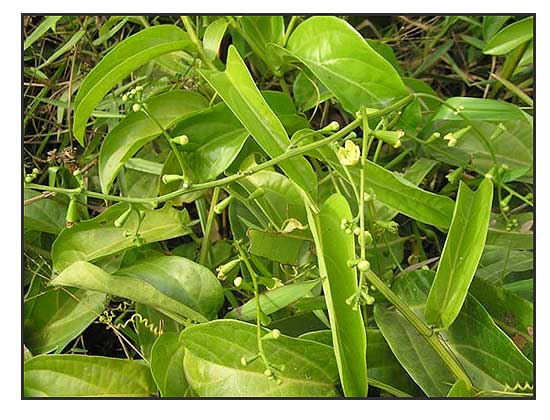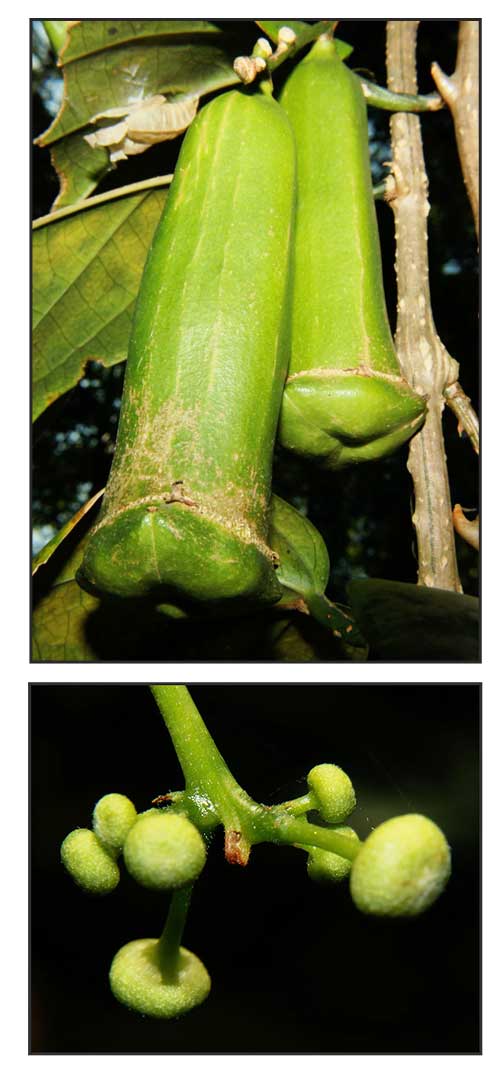
Family • Cucurbitaceae
Zanonia
Zanonia indica L.
CIRPOTA
Chi zi gua
| Scientific names | Common names |
| Zanonia indica L. | Zanonia (General) |
| Accepted infraspecifics (3) | Cirpota (Derived) |
| Zanonia indica subsp. indica | |
| Z. indica subsp. orientalis W.J.de Wilde &n Duyfjes | |
| Alsomitra simplicifolia Merr. | |
| Juppia borneensis Merr. | |
| Neoalsomitra simplicifolia (Merr.) Hutch. | |
| Zanonia indica var. angustifolia Cogn. | |
| Zanonia indica var. orientalis W.J.de Wilde & Duyfjes | |
| Zanonia indica var. pubescens Cogn. | |
| Tinospora curtisii Ridl. | |
| Zanonia indica var. paludosa W.J.de Wilde & Duyfjes | |
| Zanonia indica is an accepted speicies. KEW: Plants of the World Online | |
| Other vernacular names |
| CHINA: Chi zi gua. |
| INDIA: Lalruanga dawibur (Mizoram), Chiporta, Parpoti(Sanskrit); Chirpot (Hindi); Kuntali (Kannada); Peenarvalli (Malayalam). |
| SRI LANKA: Wal rasankinda. |
| VIETNAM: Luc lac bo, Luc lac day, Thiet bat. |
Constituents Properties Studies Availability |
November 2025
![]()
 |
| PHOTOS / ILLUSTRATIONS |
| IMAGE SOURCE: Zanonia indica / VanLap Hoang / CC BY 2.0 / Click on image or link to go to source page / Wikimedia Commons |
| OTHER IMAGE SOURCE: Zanonia indica / © eFloraOfIndia / Non-commerciial use / Click on image or link to go to source page / eFloraOfIndia |
| OTHER IMAGE SOURCE: Zanonia indica / © eFloraOfIndia / Non-commerciial use / Click on image or link to go to source page / eFloraOfIndia |
| OTHER IMAGE SOURCE: Zanonia indica leaf / © eFloraOfIndia / Non-commerciial use / Click on image or link to go to source page / eFloraOfIndia |
| OTHER IMAGE SOURCE: Zanonia indica fruit / © TUELINH / Non-commerciial use / image modified / Click on image or link to go to source page / TraCuuDuocLiue |
Additional
Sources and Suggested Readings |
• |
DOI: It is not uncommon for links on studies/sources to change. Copying and pasting the information on the search window or using the DOI (if available) will often redirect to the new link page. (Citing and Using a (DOI) Digital Object Identifier) |
| List of Understudied Philippine Medicinal Plants |
| New plant names needed The compilation now numbers over 1,730 medicinal plants. While I believe there are hundreds more that can be added to the collection, they are becoming more difficult to find. If you have a plant to suggest for inclusion, native or introduced, please email the info: scientific name (most helpful), local plant name (if known), any known folkloric medicinal use, and, if possible, a photo. Your help will be greatly appreciated. |
• |
 |





